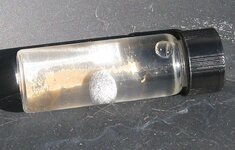Bodfish Mike
Hero Member
- Dec 12, 2014
- 505
- 1,370
- Detector(s) used
- Garrett , Whites
keene puffer drywasher , Keene A51 Sluice
- Primary Interest:
- Other
Mercury started showing in my drywash cons in a gulch I was working last fall and this is what I ended up with.
It swallow a lot of my fine gold to the point it would not any hold more.
What I found interesting is that it has hardened, if I shake it in vial it acts solid. It was not like this a 2600 feet above sea level but now that I'm in the SF bay area at 26'feet it's hardened.
I have not opened the vial at 26' yet to see what would happen.
Not sure if it would decompress like a plastic bottle.
The stuff in the back ground is silt dirt not gold.
I enjoy looking at it and feel good about taking it out of the environment.

It swallow a lot of my fine gold to the point it would not any hold more.
What I found interesting is that it has hardened, if I shake it in vial it acts solid. It was not like this a 2600 feet above sea level but now that I'm in the SF bay area at 26'feet it's hardened.
I have not opened the vial at 26' yet to see what would happen.
Not sure if it would decompress like a plastic bottle.
The stuff in the back ground is silt dirt not gold.
I enjoy looking at it and feel good about taking it out of the environment.

Amazon Forum Fav 👍
Upvote
0






